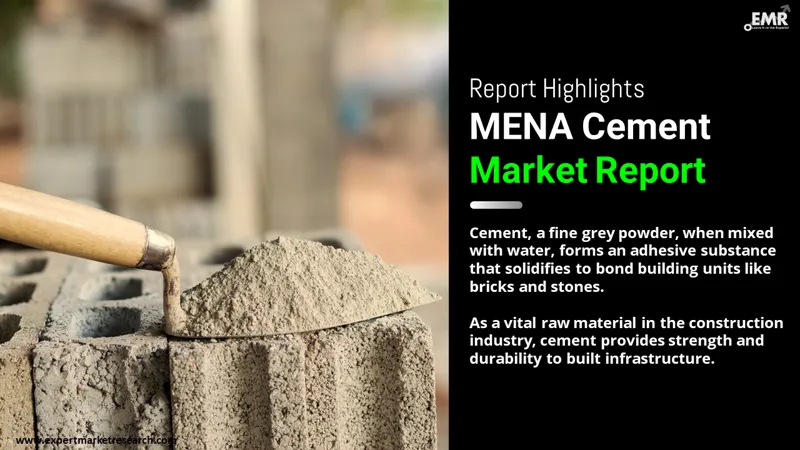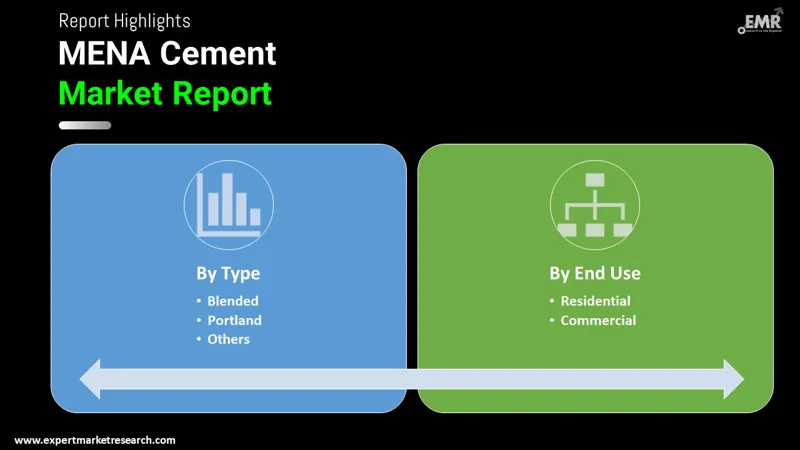
Consumer Insights
Uncover trends and behaviors shaping consumer choices today
Procurement Insights
Optimize your sourcing strategy with key market data
Industry Stats
Stay ahead with the latest trends and market analysis.
The MENA cement market attained a volume of about 797.71 MMT in 2025. The market is further expected to grow at a CAGR of 5.50% during the forecast period of 2026-2035 to reach nearly 1362.60 MMT by 2035.
Base Year
Historical Period
Forecast Period
Compound Annual Growth Rate
5.5%
Value in MMT
2026-2035
*this image is indicative*
The MENA market for cement is being driven by the robust construction projects carried out in countries like the UAE and Saudi Arabia over the recent years. The rise in commercial construction can be associated with the rapid investments in tourism and robust industrialisation, owing to which there has been a significant rise in the construction offices and other public buildings, which is a major factor augmenting the demand for cement in the region. In addition, Egypt and Saudi Arabia are significantly adding to the market demand in terms of increasing factory numbers and production capacity. These are some of the factors positively influencing the market growth in the region.

Read more about this report - REQUEST FREE SAMPLE COPY IN PDF
Moreover, the region has been witnessing a surge in its population levels owing to urbanisation and robust job opportunities, thereby inviting people from all over the world. This has led to a rise in residential construction projects over the past years, thus augmenting the demand for cement in the MENA region. In addition to this, other indirect factors like inflating disposable incomes, changing consumer lifestyles, and the growth in reconstruction projects are additional factors providing impetus to the market growth.

Read more about this report - REQUEST FREE SAMPLE COPY IN PDF
Cement is essentially a fine grey powder that is mixed with water to form an adhesive material that sets and hardens to adhere to building units, such as bricks and stones. It is an essential raw material in the construction industry that provides strength and durability to the built infrastructure.
Based on type, the market can be segmented into:
The market, based on end use, can be categorised into:
The EMR report looks into the countries of MENA market of cement like:
The MENA market for cement witnessed a restrained growth in the historical period owing to the outbreak of the COVID-19 pandemic. As a result of pandemic induced restrictions, several manufacturing, construction, and import-export industries remained shut during 2020, thereby negatively impacting the market growth in the region. In addition, a number of cement manufacturing industries in the region witnessed a negative international trade during the lockdown period, thereby hampering the market growth
However, major construction projects are predicted in countries like Saudi Arabia, such as the development of NEOM city and the 2023 Qatar World Cup, which are projected to drive the growth of the regional market during the forecast period. In addition, with ease in travel restrictions, countries like UAE are expected to undertake various construction projects, thus the invigorated demand for cement is projected to push the growth of the market. In line with this, the ongoing EXPO-2020 exhibition in Dubai is positively impacting the market growth of cement in the region.
The report presents a detailed analysis of the following key players in the MENA cement market, looking into their capacity, market share, and latest developments like capacity expansions, plant turnabouts and mergers and acquisitions:
The comprehensive report looks at the micro and macro aspects of the industry. The EMR report gives an in-depth insight into the market by providing a SWOT analysis as well as an analysis of the Porter’s Five Forces Model.




*While we strive to always give you current and accurate information, the numbers depicted on the website are indicative and may differ from the actual numbers in the main report. At Expert Market Research, we aim to bring you the latest insights and trends in the market. Using our analyses and forecasts, stakeholders can understand the market dynamics, navigate challenges, and capitalize on opportunities to make data-driven strategic decisions.*
Get in touch with us for a customized solution tailored to your unique requirements and save upto 35%!
The MENA cement market attained a volume of nearly 797.71 MMT in 2025.
The market is projected to grow at a CAGR of 5.50% in the forecast period of 2026-2035.
The market is estimated to witness healthy growth in the forecast period of 2026-2035 to reach about 1362.60 MMT by 2035.
The industry is primarily being driven by the rising commercial and residential construction projects owing to industrialisation and urbanisation.
The market is expected to be driven by the resumption of construction activities and ongoing technological advancements in the industry.
The major countries in the industries are Saudi Arabia, the United Arab Emirates, Bahrain, Kuwait, Iraq, Algeria, Egypt, Libya, and Morocco, among others.
The different types of cements in the market are blended and portland, among others.
The significant end uses of cement are residential and commercial.
The major players in the industry are CEMEX S.A.B. de C.V., Dangote Cement Plc., InterCement, HeidelbergCement AG, and CNBM International Corporation, among others.
Explore our key highlights of the report and gain a concise overview of key findings, trends, and actionable insights that will empower your strategic decisions.
| REPORT FEATURES | DETAILS |
| Base Year | 2025 |
| Historical Period | 2019-2025 |
| Forecast Period | 2026-2035 |
| Scope of the Report |
Historical and Forecast Trends, Industry Drivers and Constraints, Historical and Forecast Market Analysis by Segment
|
| Breakup by Type |
|
| Breakup by End Use |
|
| Breakup by Region |
|
| Market Dynamics |
|
| Competitive Landscape |
|
| Companies Covered |
|
| Report Price and Purchase Option | Explore our purchase options that are best suited to your resources and industry needs. |
| Delivery Format | Delivered as an attached PDF and Excel through email, with an option of receiving an editable PPT, according to the purchase option. |
Datasheet
One User
USD 2,499
USD 2,249
tax inclusive*
Single User License
One User
USD 3,999
USD 3,599
tax inclusive*
Five User License
Five User
USD 4,999
USD 4,249
tax inclusive*
Corporate License
Unlimited Users
USD 5,999
USD 5,099
tax inclusive*
*Please note that the prices mentioned below are starting prices for each bundle type. Kindly contact our team for further details.*
Flash Bundle
Small Business Bundle
Growth Bundle
Enterprise Bundle
*Please note that the prices mentioned below are starting prices for each bundle type. Kindly contact our team for further details.*
Flash Bundle
Number of Reports: 3
20%
tax inclusive*
Small Business Bundle
Number of Reports: 5
25%
tax inclusive*
Growth Bundle
Number of Reports: 8
30%
tax inclusive*
Enterprise Bundle
Number of Reports: 10
35%
tax inclusive*
How To Order

Select License Type
Choose the right license for your needs and access rights.

Click on ‘Buy Now’
Add the report to your cart with one click and proceed to register.

Select Mode of Payment
Choose a payment option for a secure checkout. You will be redirected accordingly.
Gain insights to stay ahead and seize opportunities.

Get insights & trends for a competitive edge.

Track prices with detailed trend reports.

Analyse trade data for supply chain insights.

Leverage cost reports for smart savings

Enhance supply chain with partnerships.

Connect For More Information
Our expert team of analysts will offer full support and resolve any queries regarding the report, before and after the purchase.
Our expert team of analysts will offer full support and resolve any queries regarding the report, before and after the purchase.
We employ meticulous research methods, blending advanced analytics and expert insights to deliver accurate, actionable industry intelligence, staying ahead of competitors.
Our skilled analysts offer unparalleled competitive advantage with detailed insights on current and emerging markets, ensuring your strategic edge.
We offer an in-depth yet simplified presentation of industry insights and analysis to meet your specific requirements effectively.
Share